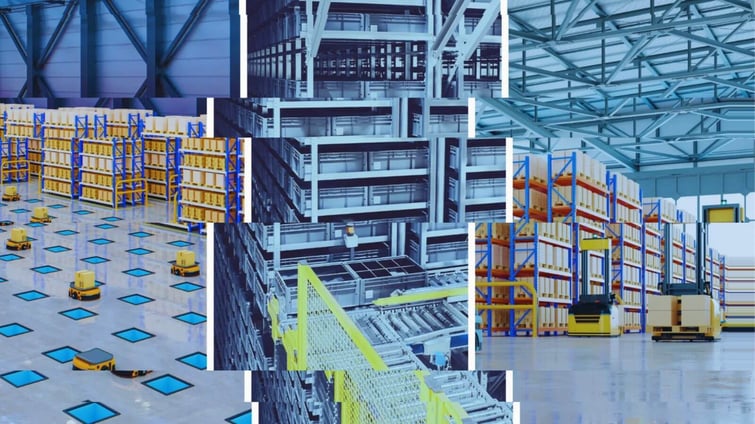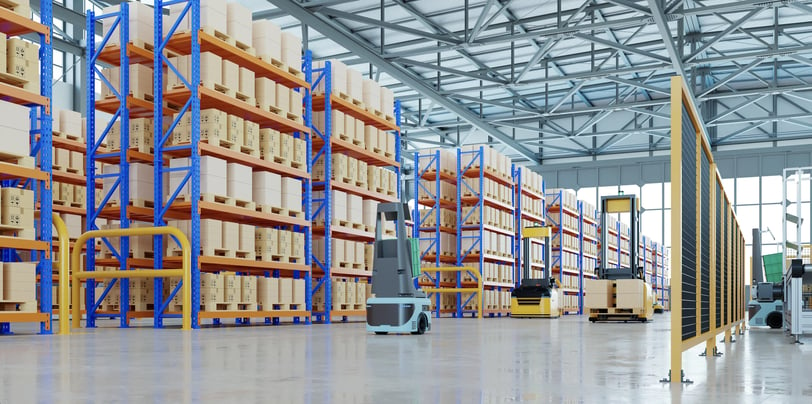How Autonomous Pallet Robots are Revolutionizing Material Handling
Autonomous pallet robots are becoming increasingly popular in material handling. In this article, we explore their benefits, types, differences, and...

AGVs: Automated guided vehicles are used in various applications to increase efficiency and productivity. In fact, it is predicted that the global AGV market will grow around 7.7% between 2021 and 2026 due to increasing demand for automation in the material handling industry. They are commonly used for transporting raw materials such as plastic, paper, rubber, and metal. Many organizations utilize AGVs to lower labor costs and shift workers’ attention to more valuable jobs. The three main types are generally tow vehicles, heavy load carriers, and automated forklifts.
Tow vehicles are estimated to hold the largest share of the AGV market in 2021. They have the highest capacity among AGVs for moving materials. Also called tugger automatic guided vehicles, they pull one or more, non-powered carts that receive loads manually or automatically.
Consider a warehouse with multiple facilities in one industrial site. The organization can use tow automated guided vehicles to transport their inventory of heavy metal between their different facilities using wire navigation to create a more efficient transportation system. This type of AGV is productive in moving heavy loads or loads that require long distances with numerous trailers, in comparison to a single fork truck.
AS/RS: Automated storage and retrieval systems technology varies based on what system will be most efficient for the type of inventory present. AS/RS include carousels, mini-load and unit-load cranes, shuttles, etc. Each of these work to increase the efficiency of pickers and are productive in moving high volumes of loads in and out of storage, reducing labor costs and labor constraints caused by shortages.
AS/RS are commonly used for picking, processing, and packing orders. Manually picking orders can account for more than 50% of the time linked to picking, making it a very time-consuming process. These systems increase picking accuracy while also making efficient use of floor space.
For instance, if a business needed to continuously move small boxes that hold parts required for a machine, it would be very time inefficient to manually move each of these boxes. Instead, they would want to implement an automated, mini-load AS/RS system that moves smaller loads, up to 350 pounds. Mini-load stacker cranes would be able to retrieve and place the boxes on racks and the operator won’t have to move from their location.
Automated storage and retrieval systems can also be used for staging orders for shipping that are outside shipping hours, transferring them into buffer storage. These systems can further buffer inventory and provide it on demand to operators at different stages in the operation process.
According to ABI research, recent high volumes in the logistic sectors have led to an increasing need for AS/RS solutions. In particular, parcel shipping reached 95 billion in volume in 2020 and is expected to double in the coming years.
AMRs: Automated mobile robots can also be used in a variety of use cases to make processes in an organization more efficient and productive without disrupting workflows. Like AGVs and AS/RS, these vehicles can add value to a business by carrying out tasks that allow workers to shift their efforts into other, more productive tasks. They therefore allow businesses to optimize labor, which reduces labor costs, in addition to increasing safety.
There are generally three types of automated mobile robots, those that transport goods, aid in the picking process, and offer a sortation solution. More generally, AMRs are widely used for logistics, e-commerce, warehousing, in addition to data centers, healthcare, etc.
We can specifically look at AMRs used in warehousing. Data shows us that the average size of a warehouse in the U.S. has increased by 143% in recent years. This opens up the demand for AMRs to assist in transporting goods and help with heavy lifting to allow workers to engage in more value-adding activities. LogisticsIQ’s report found that the global market for AMRs is projected to expand by 2025 to represent a market share of around 15% in the warehouse automation sector.
 Automated mobile robots facilitating sortation at a warehouse facility.
Automated mobile robots facilitating sortation at a warehouse facility.
Consider a warehouse that wants to automate its sorting process and implement automated mobile robots into its workflow. These automated vehicles will use intelligent technology to take a product, scan its label, and navigate the goods to the associated dispatch zone. AMRs will scan their surroundings and use this data to safely navigate to the area where the product must be placed in this sorting task. This type of AMRs will utilize a navigation system specifically designed for warehouse performance.
This is just one example of how automated mobile robots can be used in the real world. At Cyngn, we can build these autonomous vehicles and operations to the specifications of a given business. This may include basic stop-and-go routes or much more advanced ones that include a random A to random B type of operation.
AGVs and AS/RS: Unlike AMRs, AS/RS and AGVs have more infrastructure-related costs. Automated guided vehicles require costs associated with building out fixed routes for vehicles, such as wires that are embedded into a warehouse's floor. Furthermore, for automated storage and retrieval systems, organizations tend to have a high order volume that combats these initial, infrastructure costs. Factors that affect AS/RS systems prices include height, size and weight of the loads, the distribution system in place, etc.
AMRs: While automated mobile vehicles are more advanced, they can be less expensive to deploy than the other two solutions. These vehicles don’t require the same wires, tracks, and other infrastructure required for ASRS and AGVs. In addition, AMRs are flexible and can easily adapt to changes in business, further making them a cost-effective solution.
Several alternatives to Automated Guided Vehicles (AGVs) are emerging in the field of material handling and logistics automation. These alternatives often aim to provide more flexibility, adaptability, and efficiency in various industrial applications. In short, such mobile robots optimize material movement and material handling, and it's a matter of choosing the best robot for the job.
Some alternatives include:
Autonomous Mobile Robots (AMRs): These are similar to AGVs but are equipped with more advanced sensors and software that allow them to navigate and interact with their environment more autonomously. AMRs can adapt to changes in their surroundings and avoid obstacles without the need for extensive infrastructure modifications.
Drones and UAVs: Unmanned Aerial Vehicles (UAVs) can be used to transport goods across warehouses or outdoor spaces. They are particularly useful for areas that are difficult to reach using traditional AGVs or AMRs, such as large outdoor yards or tall storage facilities.
Shuttle Systems: Shuttle systems involve using small automated vehicles that move within racking systems to retrieve and transport goods. These systems are especially efficient in high-density storage environments like warehouses.
Conveyor Systems: Conveyor belts or roller systems can be used to move goods along a fixed path. These systems are particularly useful for continuous flow processes and can handle a high volume of goods.
Automated Storage and Retrieval Systems (AS/RS): AS/RS use robotic systems to store and retrieve items from racking systems automatically. They can handle a wide variety of items and are often used in high-bay warehouses.
Automated Crane Systems: These systems use robotic cranes to move and stack goods within a warehouse. They are particularly useful for handling heavy or bulky items.
Sortation Systems: Sortation systems use conveyors, chutes, and diverters to automatically sort and route items to different destinations. They are commonly used in distribution centers and e-commerce fulfillment centers.
Robotic Picking Systems: These systems use robotic arms equipped with advanced grippers and computer vision to pick and place items. They are useful for tasks that require dexterity and flexibility, such as order picking.
Tugger Systems: Tugger systems involve a central vehicle towing multiple carts or containers. These systems are flexible and can be easily adapted to transport different types of loads.
Automated Guided Carts (AGCs): Sometimes called "autonomous pallet robots", AGCs are smaller vehicles designed to transport materials within a facility. They are often used in applications where smaller loads need to be moved autonomously.
Yes, there is a distinction between "autonomous" and "automated" in the context of robotics, automation, and material handling:
Automated: Automation refers to the use of technology and control systems to perform tasks or processes without human intervention. In an automated system, the actions are predetermined and programmed in advance. It follows a set of instructions or a predefined sequence of actions. Automated systems are typically designed to repeat specific tasks accurately and efficiently. For example, an automated conveyor belt system that moves products along a fixed path without any human intervention.
Autonomous: Autonomy refers to the ability of a system or robot to perform tasks or make decisions without direct human control or intervention. Autonomous systems have the capability to perceive their environment, make decisions based on their programming or learning, and adapt to changes or unexpected situations. They often incorporate sensors, artificial intelligence, and algorithms to navigate, interact, and make decisions in real-time. For example, an autonomous mobile robot (AMR) that can navigate through a warehouse, avoid obstacles, and adjust its path to reach a destination, all without human intervention.
In the context of material handling and robotics, an automated system might follow preconfigured paths or rules to perform tasks, while an autonomous system has the ability to make decisions based on its understanding of the environment and real-time inputs. Autonomous systems are generally more adaptable and capable of handling dynamic and unpredictable situations, whereas automated systems are more suited for repetitive and well-defined tasks.
Autonomous pallet robots are becoming increasingly popular in material handling. In this article, we explore their benefits, types, differences, and...
Learn how automated solutions can enhance efficiency, reduce costs, and improve accuracy in warehouse operations.
Explore the essential principles and functions of Automated Guided Vehicles (AGVs) in our comprehensive guide.